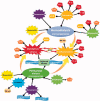Herbal antioxidants in dialysis patients: a review of potential mechanisms and medical implications
- PMID: 33593237
- PMCID: PMC7894453
- DOI: 10.1080/0886022X.2021.1880939
Herbal antioxidants in dialysis patients: a review of potential mechanisms and medical implications
Abstract
The consumption of exogenous antioxidants isolated from herbal extracts has shown beneficial effects on ameliorating dialysis-related complications through debilitating oxidative stress and inflammatory process. Many clinical studies available in public databases have reported the improved consequences of dialysis in patients supplemented with herbal antioxidants. Exploration of such data offers great possibilities for gaining insights into the potential mechanisms and medical implications of herbal antioxidants. In this work, the mechanisms and implications of some famous bioactive substances including silymarin, curcumin, resveratrol, emodin, and quercetin on the consequences of dialysis in chronic kidney disease (CKD) patients were explored. The protective features of silymarin are due to the flavonoid complex silybin. Curcumin is an active element from the root of curcuma longa with extensive beneficial properties, including antioxidant, anti-inflammatory activity, and inhibitory effects on cell apoptosis. Resveratrol can reduce the oxidative stress by neutralization of free radicals. Emodin is known as a natural anthraquinone derivative isolated from Chinese herbs. Finally, quercetin has been reported to exhibit several properties including antioxidant, anti-diabetic, analgesic, antihistaminic, antiviral, cholesterol reducer, and renal hemodynamic modulator. However, potential mechanisms and medical implications of the aforementioned herbal antioxidants seem to be more complicated, that is, more studies are required in this field.
Keywords: Dialysis; curcumin; emodin; herbal antioxidant; inflammation; oxidative stress; quercetin; resveratrol; silymarin.
Conflict of interest statement
No potential conflict of interest was reported by the author(s).
Figures
Similar articles
-
Modulation of aberrant crypt foci and apoptosis by dietary herbal supplements (quercetin, curcumin, silymarin, ginseng and rutin).Carcinogenesis. 2005 Aug;26(8):1450-6. doi: 10.1093/carcin/bgi089. Epub 2005 Apr 14. Carcinogenesis. 2005. PMID: 15831530
-
The use of an anti-inflammatory supplement in patients with chronic kidney disease.J Complement Integr Med. 2013 Jul 1;10:/j/jcim.2013.10.issue-1/jcim-2012-0011/jcim-2012-0011.xml. doi: 10.1515/jcim-2012-0011. J Complement Integr Med. 2013. PMID: 23828329 Clinical Trial.
-
Modulation of Sirtuins to address aging related disorders through the use of selected phytochemicals.Phytomedicine. 2025 Jul 25;143:156648. doi: 10.1016/j.phymed.2025.156648. Epub 2025 May 12. Phytomedicine. 2025. PMID: 40359853 Review.
-
Antioxidant effects and mechanism of silymarin in oxidative stress induced cardiovascular diseases.Biomed Pharmacother. 2018 Jun;102:689-698. doi: 10.1016/j.biopha.2018.03.140. Epub 2018 Apr 5. Biomed Pharmacother. 2018. PMID: 29604588 Review.
-
Impact of Curcumin on Traumatic Brain Injury and Involved Molecular Signaling Pathways.Recent Pat Food Nutr Agric. 2020;11(2):137-144. doi: 10.2174/2212798410666190617161523. Recent Pat Food Nutr Agric. 2020. PMID: 31288732 Review.
Cited by
-
Enhanced Oxidative DNA-Damage in Peritoneal Dialysis Patients via the TXNIP/TRX Axis.Antioxidants (Basel). 2022 Jun 6;11(6):1124. doi: 10.3390/antiox11061124. Antioxidants (Basel). 2022. PMID: 35740021 Free PMC article.
-
A Glimpse of Inflammation and Anti-Inflammation Therapy in Diabetic Kidney Disease.Front Physiol. 2022 Jul 6;13:909569. doi: 10.3389/fphys.2022.909569. eCollection 2022. Front Physiol. 2022. PMID: 35874522 Free PMC article. Review.
-
A Comprehensive Review of the Cardiovascular Protective Properties of Silibinin/Silymarin: A New Kid on the Block.Pharmaceuticals (Basel). 2022 Apr 27;15(5):538. doi: 10.3390/ph15050538. Pharmaceuticals (Basel). 2022. PMID: 35631363 Free PMC article. Review.
-
Nephroprotective Effect of Fennel (Foeniculum vulgare) Seeds and Their Sprouts on CCl4-Induced Nephrotoxicity and Oxidative Stress in Rats.Antioxidants (Basel). 2023 Jan 30;12(2):325. doi: 10.3390/antiox12020325. Antioxidants (Basel). 2023. PMID: 36829884 Free PMC article.
-
Investigation of the Renal Protective Effect of Combined Dietary Polyphenols in Streptozotocin-Induced Diabetic Aged Rats.Nutrients. 2022 Jul 13;14(14):2867. doi: 10.3390/nu14142867. Nutrients. 2022. PMID: 35889824 Free PMC article.
References
-
- Gorostidi M, Santamaría R, Alcázar R, et al. . Spanish Society of Nephrology document on KDIGO guidelines for the assessment and treatment of chronic kidney disease. Nefrologia. 2014;34(3):302–316. - PubMed
-
- Liyanage T, Ninomiya T, Jha V, et al. . Worldwide access to treatment for end-stage kidney disease: a systematic review. Lancet. 2015;385(9981):1975–1982. - PubMed
Publication types
MeSH terms
Substances
LinkOut - more resources
Full Text Sources
Other Literature Sources
Medical

